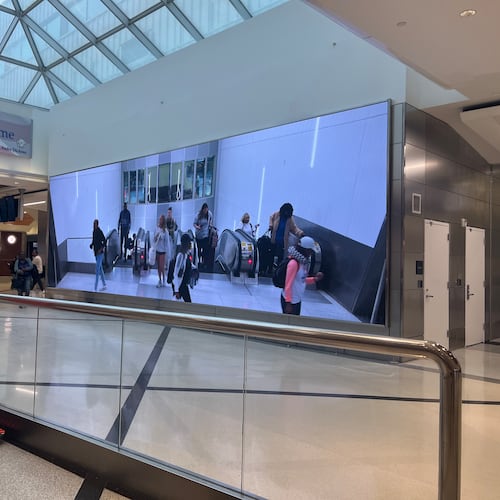With Christmas less than a week away, the nation’s public and private shippers are struggling to deliver record numbers of packages, and analysts say consumers should be prepared for delays.
The Postal Service is expecting up to a third more packages this year than last, Postmaster General Louis DeJoy said in a video message Dec. 14. The agency said Dec. 14-21 is its busiest week in “an extraordinary year of unprecedented challenges.”
Sandy Springs-based UPS, the world’s largest package delivery company, has already seen shipping volumes skyrocket for much of the year as the COVID-19 pandemic prompted consumers to order online a never-ending stream of products for delivery to their doorsteps.
That’s leading to a record year for the holiday shipping rush — even bigger than a normal year when the volume of packages can double as the December holidays approach.
Then, layer on top of that the need for urgent shipments of life-saving vaccines across the country, and you have a perfect storm of unprecedented demands on shipping networks across the country and the world.
In Georgia, the postal service is also under pressure to timely process absentee ballots ahead of the Jan. 5 runoffs. USPS has already processed 1.2 million ballots, including ballots sent to Georgia voters and returned to state election officials, according to USPS spokesperson Rick Badie.
Whether packages arrive on time or not matters most on Dec. 24, when there are empty spots to fill under the tree.
That makes the next several days the most crucial for UPS, FedEx and the entire logistics industry. For the consumer, packages can still be shipped this week — for a cost.
Credit: Christina Matacotta
Credit: Christina Matacotta
Anyone ordering items online throughout the year is likely to have noticed that some shipments took longer than normal to arrive. Some delays in logistics networks were initially due to shortages and prioritization of personal protective equipment. But some longer delivery times have persisted through much of the year — and UPS and FedEx have both suspended on-time service money-back guarantees due to the pandemic.
Consulting firm Deloitte predicted e-commerce sales would grow 25-35% year-over-year this holiday season. DHL Express, which handles international shipments, has also seen package volumes surge as much as 45% this year.
FedEx on its website warns that “Record high volumes of e-commerce orders, COVID 19 closures and weather events may cause delivery delays.”
On-time delivery rates have declined. For the period Dec. 13-17, UPS had an on-time delivery rate of 94.9%, FedEx was at 92.1% and the U.S. Postal Service at 86.1%, ShipMatrix figures show. The Postal Service is facing challenges from excess volume it has received due to restrictions by FedEx and UPS, and millions of parcels are being delayed one or more days, according to ShipMatrix.
Small retailers hit hard
The delays are causing havoc for small businesses, who are relying on increased deliveries during the holiday season to make up for a sluggish year of pandemic sales. Charles Thurman, 57, makes a living selling collectible DVDs, books and other media on eBay from his home in Alpharetta. Ever since he launched his business in 2010, “USPS has been about as perfect as you could get,” he said.
This fall, that changed. Thurman said that packages he mailed the week after Black Friday still haven’t reached their destination, and that his daily digest from the Postal Service day after day reports expected deliveries that never arrive.
“I can’t put stuff up for auction because I don’t have it,” Thurman said. “I’ve had to refund several people already.”
In a statement, the Postal Service acknowledged “temporary delays,” and attributed the problems to “historic record of holiday volume compounded by a temporary employee shortage due to the COVID-19 surge, and capacity challenges with airlifts and trucking for moving this historic volume of mail.”
In an attempt to handle the increased volume, USPS expanded Sunday delivery, holiday retail hours and package delivery window in some locations.
“We continue to flex our network including making sure the right equipment is available to sort, process and deliver a historic volume of mail and packages this holiday season,” USPS chief retail and delivery officer Kristin Seaver said in a statement.
John Haber, CEO of Atlanta-based supply chain consulting firm Spend Management Experts, said some retailers “are struggling to stay alive, they’re trying to sell as much as possible.... (but)are having to cut off sales” because the carriers don’t have enough capacity to pick up the packages.
“I’ve never seen capacity controlled as tightly as it has been this peak season,” said Haber.
Vaccines in the pipeline
Mid-December winter storms have also gummed up shipping networks, delaying flights and trucks.
“Once you get behind, it’s really difficult to pull out and recover,” Haber said.
Vaccines, which are temperature and time-sensitive, are also taking precedence over other shipments, and flights carrying vaccines will also be given priority by the FAA when needed, according to UPS and FedEx officials during testimony at a Senate committee.
“There will be no higher priority shipments in our network than these vaccine shipments,” FedEx regional president of Americans Richard Smith said at the hearing.
The challenges for shipping could become even greater with the start of Moderna vaccine shipments, Haber said.
“For last-minute shoppers, it’s very risky right now. A lot depends on the weather and things like that,” Haber said. “Certainly, there are going to be millions of packages that are not going to be delivered on time.”
The Latest
Featured



